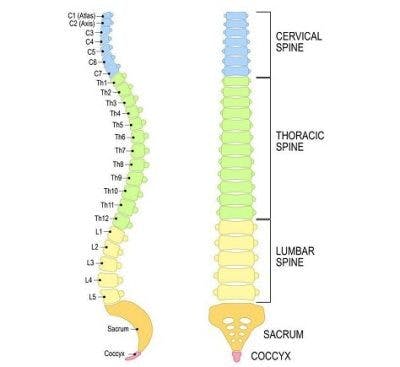No products in the cart.
No products in the cart.
No products in the cart.
No products in the cart.
Home » Neurological Recovery Blog » Spinal Cord Injury » Spinal Cord Injury Respiratory Complications: Causes, Risks, and Management
Last updated on January 26, 2021

Because respiratory complications are the leading cause of death in individuals with spinal cord injuries, it’s essential to understand what causes them and how to manage them.
To help you prepare, this article will discuss how a spinal cord injury can affect respiratory functions, the most common respiratory complications that occur after SCI, and effective management interventions.

A high-level spinal cord injury can disrupt control over an important respiratory muscle called the diaphragm.
Specifically, the C3, C4, and C5 spinal nerves innervate the diaphragm. After a spinal cord injury at or above the C5 level, messages from the brain may not be able to get past the damage, resulting in loss of control over the diaphragm.
This causes breathing to be weakened, therefore it’s essential to seek immediate medical attention. With the help of a ventilator, respiratory functions may be restored.
Generally, the higher one’s level of injury, the greater their risk of experiencing respiratory complications. While respiratory complications are most common after cervical spinal cord injuries, they can also occur (to a less severe extent) after thoracic injuries. The thoracic nerves mostly control the muscles in your trunk. Without motor control over the intercostal (the muscles in-between in the ribs) and abdominal muscles, individuals may experience decreased lung volume and weak coughing.
Additionally, individuals with spinal cord injuries are more likely to experience respiratory complications within the first year after injury because this is when respiratory functions are weakest. Fortunately, during the first year, spontaneous improvements in respiratory functions often occur.
Now that you understand how spinal cord injuries can affect respiratory functions, let’s discuss some of the most common respiratory complications among individuals with SCIs.
Various respiratory complications can arise following a spinal cord injury due to loss of control of the diaphragm, low lung volume, and weak coughing.
Below, we’ll discuss 5 common respiratory complications that can occur after SCI:
Breathing facilitates the exchange of oxygen into the body and CO2 out of the body. Respiratory failure occurs when your blood doesn’t have enough oxygen and/or too much CO2.
Without enough oxygen or with too much CO2, the body cannot properly function. This can result in difficulties breathing, a blue tint around the face, disorientation, and if left untreated, will result in death.
Pneumonia is the leading cause of death in individuals with spinal cord injuries.
It’s caused by a respiratory infection that inflames the tissues in the lungs, causing secretions to fill the air sacs. Individuals with spinal cord injuries often do not have a strong enough cough to get rid of the buildup, which causes secretions to accumulate.
Those with pneumonia may experience shortness of breath, pale skin, fever, and excessive congestion.
Individuals generally respond well to antibiotics, but alternative treatments include suctioning, quad coughing, and air-pressurizing technologies.
Another common respiratory complication that can occur after a spinal cord injury is pulmonary embolism. Pulmonary embolism occurs when a blood clot blocks the arteries in the lungs, making it difficult to breathe.
The heart pumps blood to the lungs, where it is oxygenated and returned to the heart to get pumped throughout the rest of the body. During pulmonary embolism, blood flow is restricted and cannot get oxygenated. This results in low blood-oxygen levels, which ultimately causes the body to dysfunction.
Treatment for pulmonary embolism typically consists of using blood thinners, and in some cases, surgery.
Sleep apnea is a condition characterized by unstable breathing during sleep. As a result, individuals may wake up multiple times throughout the night and fail to get a full night’s rest. Those with sleep apnea usually experience snoring and sleepiness during the day.
The respiratory system works harder while you’re sleeping; however, with a spinal cord injury, muscle weakness and low lung volume can contribute to additional respiratory distress.
Treatment for sleep apnea usually involves the use of a continuous positive airway pressure device (CPAP) that supplies pressurized air into your airways while you sleep.
Atelectasis describes the complete or partial collapse of the lungs due to blocked airways. This is primarily attributed to low lung volume following spinal cord injury.
Additionally, atelectasis is often asymptomatic until it affects a larger area of the lungs. When this happens, individuals may experience dyspnea (shortness of breath), coughing, and chest pain.
In the following section, we’ll discuss tips for managing respiratory complications after spinal cord injury.
Because respiratory complications can affect each individual differently, it’s essential to seek personalized care. Depending on the severity of one’s respiratory complications, different management interventions will be necessary.
Some of the most effective interventions to manage respiratory complications after SCI include:
Because individuals with spinal cord injuries are more susceptible to respiratory complications, it’s essential to be proactive and take preventive measures. If you notice signs of respiratory complications, seek early medical attention to prevent them from progressing.
A spinal cord injury can affect control over the muscles necessary for breathing. As a result, individuals may experience low lung volume and a weakened cough, which increases their risk of developing respiratory complications.
We hope this article helped you become more aware of potential respiratory complications that can arise after a spinal cord injury and how to manage them.

Get instant access to our free exercise ebook for SCI survivors. If you liked this post, you’ll LOVE our emails and ebook.
Each exercise features pictures of a licensed therapist to help guide you. You’ll also receive our popular recovery emails with SCI survivor stories and other useful tips — you can opt out anytime.
We will never sell your email address, and we never spam.


Flint Rehab is the leading global provider of gamified neurorehab tools. Check out our bestselling tool by clicking the button below:
Depending on the severity of your spinal cord injury, there may be hope for improved mobility. Consistent at-home therapy is key to making this happen.
That’s why Flint Rehab created FitMi, a motion-sensing, gamified home recovery tool designed for neurological injury like SCI.
Here’s what others have said about it:
“I purchased this wonderful equipment for the use of spasticity for my right hand. Initially I wasn’t sure if it would work because of the various treatments I tried and also many physiotherapists who tried their level best, but didn’t achieve any positive results.
However after trying FitMi, I could feel that slowly and steadily I am improving. It’s really a great device that minutely takes care of each and every muscle of your affected body part. The biggest plus point is, you can use this device anywhere, anytime with precise exercises that you need and also saves your money and time spent on your physiotherapist.“
— Chandrakiran
FitMi works by encouraging you to practice rehab exercises with high repetition. On average, survivors complete hundreds of repetitions per half hour session.
“Massed practice” like this helps stimulate and rewire the nervous system. While you can achieve massed practice with a written sheet of exercises, it can be tough to stick with it consistently — and consistency is key to recovery.
FitMi helps transform rehab exercises into an engaging, interactive experience. The yellow and blue “pucks” track your movement and provide feedback. All of this comes together for a motivating home therapy program.
A survivor named Tom put it perfectly:
“I believe this device will help me concentrate on making the repetitive actions needed to obtain further movement range in my wrist and hand and arm and therefore rating it with five stars. My occupational therapist recommended to give this a try. I have been using FitMi for just a few weeks. I feel more at ease in flexing.”
If you’d like to learn more about FitMi, click the button below:

Do you have this 15 pages PDF of SCI rehab exercises?
Get a free copy of our ebook Rehab Exercises for Spinal Cord Injury Recovery. Click here to get instant access.
Grab a free rehab exercise ebook!
Sign up to receive a free PDF ebook with recovery exercises for stroke, traumatic brain injury, or spinal cord injury below: